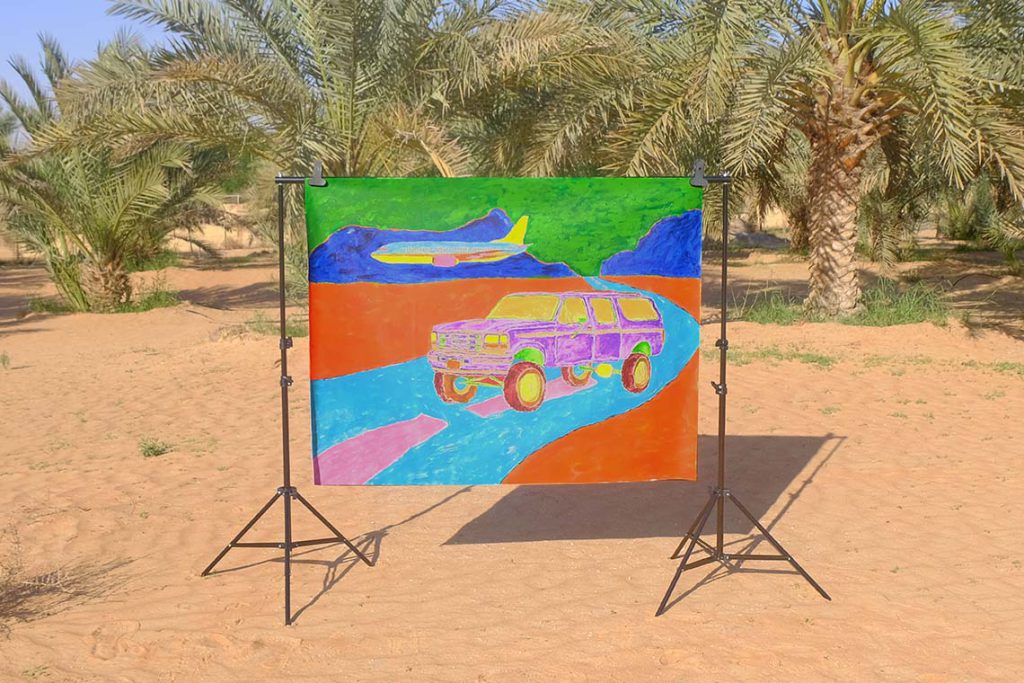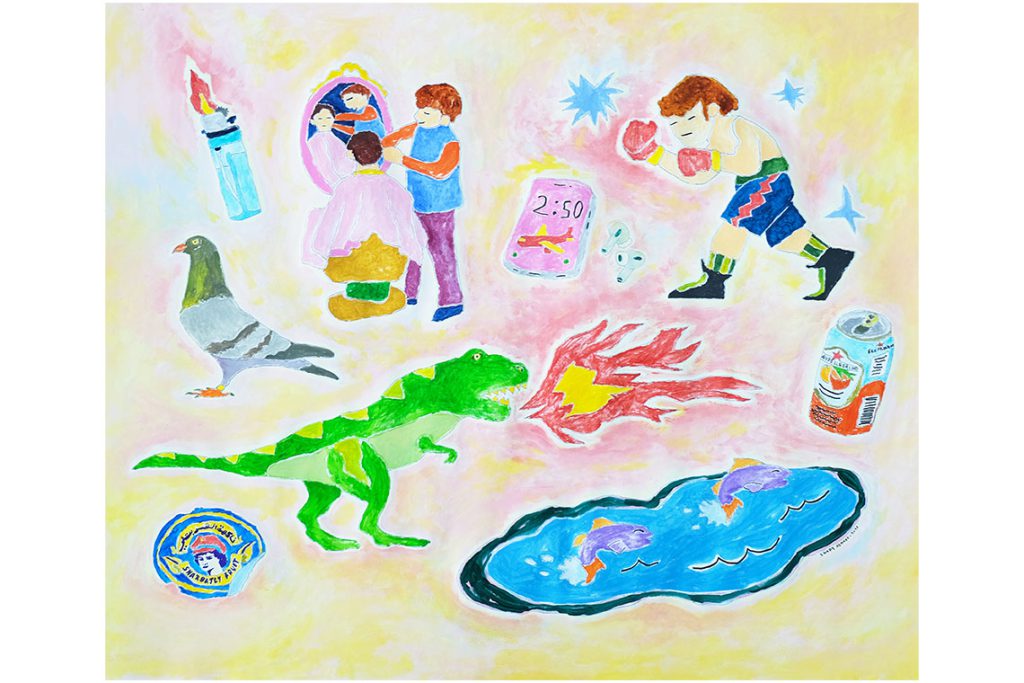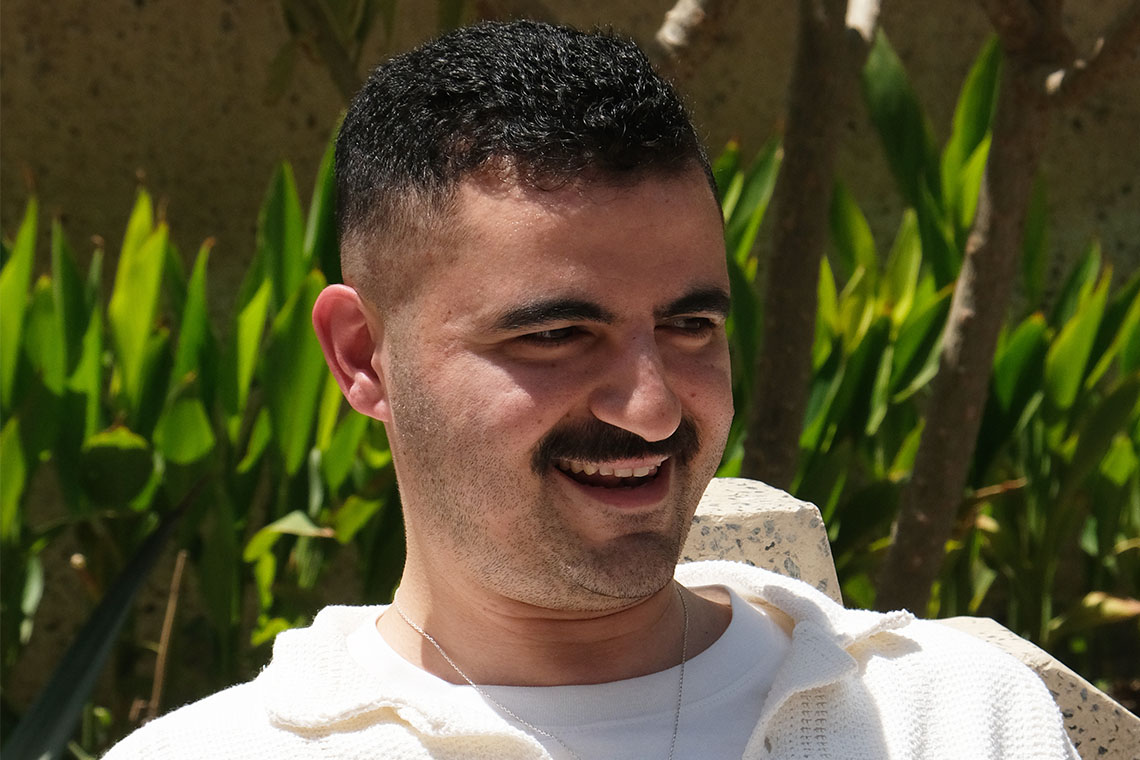The artist discusses how a childhood fascination with early digital tools evolved into a profound artistic journey, seamlessly interlocking graphic design with paintings that evoke a sense of nostalgia.
Canvas: Did growing up in Kuwait influence your art practice as a Palestinian-Jordanian in the diaspora?
Shady Al Hady: Definitely! There was always this sense of movement, especially during school breaks when students would return to their home countries and then come back to Kuwait. Most summers we travelled to Jordan, but I didn’t fully grasp it then. I thought Kuwait was my country. Listening to my family members, watching TV shows, and being around people, I developed a new understanding of what motherland means. I think this is what sparked my interest in stations and airports, because that’s where my emotions are intensified.
Whenever I’m flying, my feelings are heightened. I begin reminiscing about the people I miss. When I write a message on a plane and read it later, I realise how emotional it is, filled with deep sentiments. Perhaps growing up in the diaspora and travelling between countries planted the seeds for these emotions. I’ve also become deeply connected to places. For instance, I still visit my childhood home occasionally, and every time I pass by, it evokes a sense of nostalgia. These experiences have undoubtedly had a positive influence on me as an artist.
How does this relate to the symbolism in your work, for example the airplanes and cars in series such as Airport Road (2021)?
I grew up in a house where the sky was a thoroughfare for airplanes. Their presence and the accompanying sounds always evoked a sense of wonder. As a child, I believed airplanes were not man-made but brought from another planet. The journey from home to the airport, whether in Kuwait or Jordan, was special to me. The experience of listening to music in the car while watching planes fly by left me with a treasure trove of memories, deeply embedded in my being.

Where did your artistic journey begin and has your background in graphic design and animation influenced the visual language of your art?
As a child I didn’t always know how to express myself. I remember times when people would ask me questions and I would look up at my mom, waiting for her to answer. My family brought home our first computer in 1998 and I started using Microsoft Paint, and later on, I discovered Photoshop. The moment I started using this software it felt as if this tool was interpreting my feelings. I didn’t realise it then, but this was the beginning of my affinity for expressing myself and communicating visually. Then, during a visit to Jordan, my father introduced me to a friend who owned a design agency with a department dedicated to graphic design. That’s when I learnt what graphic design entailed. It was as if a light bulb had been switched on inside me.
After high school, I decided to study graphic design at university. The first two years were strictly about learning the basics of art, such as sketching and painting. These courses allowed me to express my individuality, and this was a pivotal moment when I realised that pursing a creative career in arts was what I wanted to do. We are usually restricted to language, but with visual art, the possibilities for expression are endless.
What differences are there between the art scenes in Jordan and Kuwait?
During my summers in Jordan, I used to rent VHS tapes to watch video clips of musicians Hamid El Shaeri and Amr Diab, as well as various commercials. As I travelled through Jordan, I noticed different artistic styles compared to back home in Kuwait, where I vividly remember the Ahmadi souk, where the signs for barbers, tailors and restaurants were hand-painted, each with a distinctive style. This contrast in artistic expression highlights how immigration can introduce varied visual elements into a new locale. In Jordan, there’s a more consistent style in art and design that reflects a long-standing cultural continuity during the 1990s and 2000s. However, with the rise of the internet, artistic styles are converging globally, blending influences and creating a more unified design approach.

What can you share about your recent show في رحلته الأولى ، شعر بالمتعة و السرور [On his first journey, he felt joy and happiness] at Gallery Bawa in Kuwait?
The morning after the exhibition opening, I woke up and asked myself where I had been the night before, because there were paintings I had completely forgotten about! Some were painted years ago. Seeing these paintings brought back feelings from when I was ten years old, it was a real journey through time. The works also sparked curious enquiries from visitors, each question prompting me to delve into the memories encapsulated by the pieces. It felt like stumbling into a black hole, where time and space are fluid and everything becomes a portal to another world.
What was the process of going from animation and graphic design to painting and sculpture? Was this a natural progression or did something prompt the change?
Both go hand in hand. Earlier in my career, I wasn’t proficient at freehand drawing but used to paint murals with my dad. I was heavily influenced by graffiti artists, especially those who write quotes on walls. Even at school, I saw the desk as a canvas to draw on. When I began studying at university, electronic devices were not allowed, so everything had to be done by hand. By the end of the second year, we started using programmes such as Illustrator and Photoshop, delving deeper into the world of design.
However, the moment my hand touches the canvas, I get this indescribable feeling. It’s like a jolt of electricity from my hand to my brain – as if a new soul is brought to life. When you’re on the computer, you’re constantly in motion. I don’t think the human mind has fully evolved to the stage where the sound of the keyboard clicking is an expression in itself. It is different from drawing, and the stronger the connection between your mind and your hand, the deeper your expression becomes.
When an idea strikes me, I sketch it out, sometimes I snap a picture on my phone then scan it into Illustrator or Photoshop to edit. I print it out and make alterations, then transfer it onto canvas and begin to draw. I enjoy painting over multiple days, often not in one continuous session, because emotions change. Changing the background colour on a canvas can take hours, but with digital photos it’s just one click, so I believe they complement each other perfectly.
This interview first appeared in Canvas 114: Once Upon A Time



